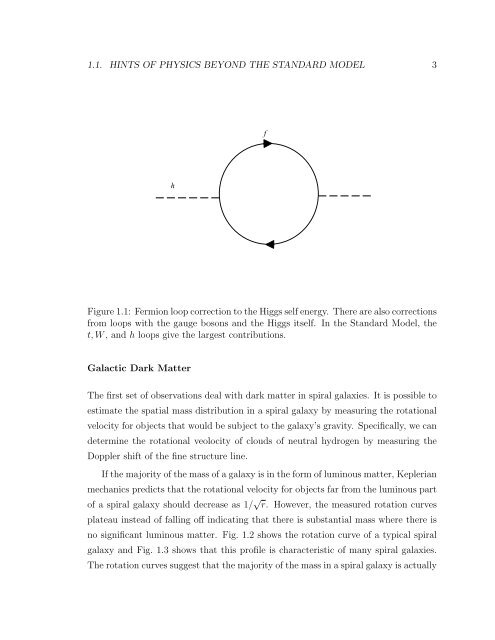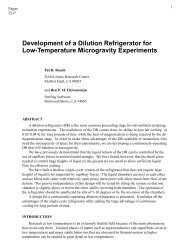cdms-ii - CDMS Experiment - University of California, Berkeley
cdms-ii - CDMS Experiment - University of California, Berkeley
cdms-ii - CDMS Experiment - University of California, Berkeley
Create successful ePaper yourself
Turn your PDF publications into a flip-book with our unique Google optimized e-Paper software.
ç<br />
1.1. HINTS OF PHYSICS BEYOND THE STANDARD MODEL 3<br />
f<br />
h<br />
ç<br />
Figure 1.1: Fermion loop correction to the Higgs self energy. There are also corrections<br />
from loops with the gauge bosons and the Higgs itself. In the Standard Model, the<br />
t, W , and h loops give the largest contributions.<br />
Galactic Dark Matter<br />
The first set <strong>of</strong> observations deal with dark matter in spiral galaxies. It is possible to<br />
estimate the spatial mass distribution in a spiral galaxy by measuring the rotational<br />
velocity for objects that would be subject to the galaxy’s gravity. Specifically, we can<br />
determine the rotational veolocity <strong>of</strong> clouds <strong>of</strong> neutral hydrogen by measuring the<br />
Doppler shift <strong>of</strong> the fine structure line.<br />
If the majority <strong>of</strong> the mass <strong>of</strong> a galaxy is in the form <strong>of</strong> luminous matter, Keplerian<br />
mechanics predicts that the rotational velocity for objects far from the luminous part<br />
<strong>of</strong> a spiral galaxy should decrease as 1/ √ r. However, the measured rotation curves<br />
plateau instead <strong>of</strong> falling <strong>of</strong>f indicating that there is substantial mass where there is<br />
no significant luminous matter. Fig. 1.2 shows the rotation curve <strong>of</strong> a typical spiral<br />
galaxy and Fig. 1.3 shows that this pr<strong>of</strong>ile is characteristic <strong>of</strong> many spiral galaxies.<br />
The rotation curves suggest that the majority <strong>of</strong> the mass in a spiral galaxy is actually




